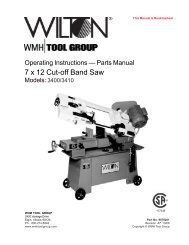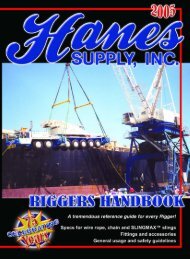Continental L-Head Overhaul Manual - Igor Chudov
Continental L-Head Overhaul Manual - Igor Chudov
Continental L-Head Overhaul Manual - Igor Chudov
You also want an ePaper? Increase the reach of your titles
YUMPU automatically turns print PDFs into web optimized ePapers that Google loves.
CHECKING BORE WEAR<br />
1. Clean the ring of carbon from around the top<br />
of the cylinder bore formed above the travel of<br />
the top ring.<br />
2. Determine the original diameter of the cylinder<br />
barrel by checking this unworn area with a<br />
pair of inside<br />
proximately ° .<br />
45<br />
micrometers at intervals of ap-<br />
Figure 126 m. Measuring original bore diameter<br />
above ring travel<br />
3. Check in same manner the top of the ring<br />
travel area approximately 1~,, below the<br />
shoulder.<br />
4. The maximum difference in the above checks,<br />
indicates the amount of cylinder bore wear. If<br />
less than .008, re-ringing will be suitable and if<br />
over .008 re-boring is recommended.<br />
CONTINENTAL L-HEAD ENGINE MANUAL Page 57<br />
PREPARING CYLINDER WALL5 FOR RE-RINGING<br />
OR REBORING<br />
1. Ridge ream the cylinders to remove the unworn<br />
area at the top so that the new rings when<br />
assembled will not bump and distort both themselves<br />
and the piston lands.<br />
Figure 127 ~ Ridge reaming top of cylinder bore<br />
Several good makes of ridge reamers are available<br />
which will ream the top of the bore in direct<br />
relation to the worn area so that should the worn<br />
area be off center slightly there will be no partial<br />
ridge remaining.<br />
2. Drain the crankcase and remove the oil pan.<br />
3. Remove the cap screws holding the connecting<br />
rod caps to the rod. Keep the cap and bolts<br />
in numerical order so that when the pistons and<br />
rods are removed from t~e engine, the cap can<br />
be reassembled and kept with its mating part.<br />
4. Push the pistons and connecting rods up<br />
through the top of the cylinder, carrying with<br />
them all the carbon and metal chips left from<br />
the cleaning and ridge reaming operation. When<br />
doing this. c~’c’r~l precc~ution must bc taken to<br />
prc~’ent da~?~cUle ~o cylinder bores by the st~arp<br />
corners and ?’o~gt~ ~’dgcx of the connecting rod,~<br />
and bolts.<br />
5. To get the correct cross hatch pattern with<br />
a cylinder hone, use a top quality electric drill<br />
with a speed of 500 RPM or less.
















